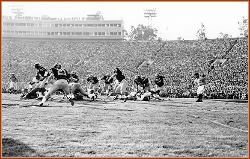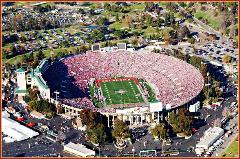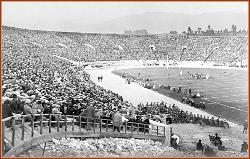Doak Campbell Stadium
Bobby Bowden Field at Doak Campbell Stadium is the football stadium on the campus
of the Florida State University in Tallahassee, Florida. It is the home venue for the
university's Seminoles football team. The stadium was named for Doak S. Campbell, a
past president of the university and the field was named for head football coach
Bobby Bowden. The stadium is part of the University Center complex, a mixed-use
facility encompassing university office space, university classrooms, the university's
Visitor's Center, souvenir store, The University Center Club, as well as skyboxes and
press boxes for use during football games. Following the latest expansion in 2003, the
stadium has a seating capacity of 82,300. On November 20, 2004, in accordance with
an act of state legislation, the stadium and field were renamed Bobby Bowden Field at
Doak Campbell Stadium.
Florida State Seminole Statues
Unconquered
19 foot (5.8 m) tall bronze sculpture by Fritz White depicting Chief Osceola and Renegade. A tradition was
immediately put in place whereby at sunset, on the night before home football games, as the Marching
Chiefs play, Osceola's spear was set aflame as students, alumni, and fans gather around the statue to
show their support. The flame was later extinguished at sunrise on the morning following the game. As of
March, 2006, the university decided to light the spear for several reasons, including: selection into the
NCAA basketball tournament, "National Player of the Year" awards for any sport, conference
championships, graduations and convocations, etc.[1] A small inscription near the base of the statue
reads: "This statue does not depict any particular person or event. Rather, it symbolically portrays the
unconquered spirit of the Seminole people of the 19th century and the timeless legacy of that spirit that
continues to burn bright into the future.". The statue was unveiled at the Williams Family Plaza on October
10, 2003, and "Unconquered" was engraved in its stone pedestal on September 2, 2005.



Sportsmanship
A bronze sculpture by
Edward Jonas, is a
15-foot (4.6 m) tall
statue depicting a
standing football player
extending his arm to help
pick up a fallen rival on
the field. In 2002 the
statue was selected by
the National Sculpture
Society to be showcased
in its special exhibit
"Sports Sculpture". A
one-quarter life size
scale model represented
the sculpture in the New
York exhibition. The
statue is located at the
Al D. Strum Plaza.
Bobby Bowden
sculpture
The sculpture, created
by renowned sculptor W.
Stanley "Sandy" Proctor,
was unveiled on the eve
of the Sept. 25 FSU vs.
Clemson game.
Tallahassee residents
and boosters Pat and
Pam Roberts
commissioned the
9-foot-tall statue, which
was dedicated along with
the Les and Ruth Akers
Plaza Sept. 24 at the
athletic center.
Evolution of Doak Campbell Stadium
From a maximum capacity of 15,000 in 1953 to a record crowd of 83,042 against Florida in 2000, Doak S. Campbell Stadium has risen
alongside the Florida State football program to the top of the college football ladder. With the final phase of construction completed, Seminole
fans are welcomed with state-of-the-art additions. The newest portion of the stadium is the south end zone, where the last bricks have been
placed on the exterior of the stadium wall and the interior received its final finishing touches. The south end zone houses the Florida State
school of hospitality education where students in the program receive hands-on experience in various aspects of the food and beverage
industry. The multi-level facility includes a food court, a restaurant and a sports grill on the top floor that gives a panoramic view of Doak
Campbell Stadium.
The north endzone, which consisted of wood bleachers until the 1994 season kicked off, is topped by the offices of the football coaches. The
offices are just part of the Daisy Parker Flory wing of the Moore Athletic Center which include a number of amenities for the football staff. An
even more drastic change is currently taking place as the new north endzone building is under construction to be ready by the start of the
2003 football season. Towering above college football action from the east side are skyboxes which stretch from goal line to goal line. New
skyboxes are located above the west stands on the eighth floor. The west addition also houses the president's level on the seventh floor
(which includes an open air terrace in the northwest corner) and one of the largest press boxes in college football with seating for over 250
members of the media.
A brick facade surrounds the stadium, matching the architectural design of most of the buildings on the Florida State campus. The University
Center surrounds Doak Campbell Stadium and houses numerous offices that were located on the interior of the FSU campus.
Inside Doak Campbell, the lowest tier of field level seats were removed, providing increased sideline space and better viewing lines for the first
few rows of fans. A matching brick wall was constructed along the east and west sidelines, limiting field access, increasing safety and giving the
inside of the stadium a whole new look.
In its last 86 home games, FSU is 81-4-1. Bobby Bowden's Florida State teams have lost only 18 games at home in 26 years, giving the coach
an impressive 132-18-2 record and an .875 winning percentage in Tallahassee. A milestone was reached on September 28, 1996 when
Bowden won his 100th game in Doak Campbell Stadium as FSU's head coach with a 13-0 victory over North Carolina.
But the winning tradition of Doak Campbell Stadium, which was named after former FSU president Doak S. Campbell, goes back before
Bowden. All-time, Florida State is 214-68-4 in 284 home games for a winning percentage of .755.
Since the stadium opened on Oct. 7, 1950 with Florida State University taking a 40-7 victory over the Randolph-Macon Yellowjackets, millions
of fans have packed Doak Campbell to see the finest in college football action. In 2001, Florida State set a single season attendance mark by
drawing 488,645 fans over six home games. The latest expansion is the ninth in the history of the stadium. The current capacity of 82,000
reflects an increase of 21,481 since the end of the 1991 season.
Florida State first began play at Centennial Field during the inaugural 1947 season. In the three seasons that the Seminoles called Centennial
Field their home, FSU had an overall home record of 8-4, including Coach Don Veller's undefeated 8-0 home mark over the 1948 and '49
seasons.
It's hard to imagine the first Doak Campbell Stadium, with a capacity of 15,000 back in 1950. In 1954, the stadium grew to a capacity of 19,000.
Six thousand more seats were added in 1961. During the Bill Peterson era (1960-70), the stadium was expanded to 40,500 seats, and it
remained at that capacity for the next 14 years. Between 1978 and 1982, there were three more additions.
The field itself is one of the finest in college football, carefully managed and manicured year-round. A prescription athletic turf (PAT) system
installed in 1988 and completely resodded three years ago, quickly alleviates drainage problems through a series of underground pumps. The
field can go from flooded to merely wet in a matter of minutes, thanks to the pumps, which allow a deeper root system in the natural turf.
The 1999 season marked another new addition to Doak Campbell Stadium as FSU unveiled the War Board video system. The big screen
presentation is crystal clear and allows game day producers to show highlights of games all over the country to Seminole fans watching their
team in the stadium. With the changes already made since last season, Doak Campbell is growing and improving faster than ever before. Like
its residents, the most successful college football program over the past decade, Doak Campbell Stadium has become a fitting showcase for
Florida State University.















